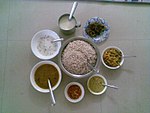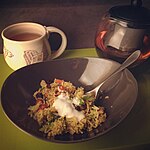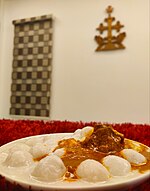Culinary style originated in Kerala
This article has multiple issues. Please help improve it or discuss these issues on the talk page. (Learn how and when to remove these messages)
|
Kerala cuisine is a culinary style originated in the Kerala, a state on the southwestern Malabar Coast of India. Kerala cuisine offers a multitude of both vegetarian and non-vegetarian dishes prepared using fish, poultry and red meat with rice as a typical accompaniment. Chillies, curry leaves, coconut, mustard seeds, turmeric, tamarind, asafoetida and other spices are also used in the preparation.


Kerala is known as the "Land of Spices" because it traded spices with Europe as well as with many ancient civilizations with the oldest historical records of the Sumerians from 3000 BCE.
Historical and cultural influences
In addition to historical diversity, cultural influences, particularly the large introduction of Muslims and Christians, have also added unique dishes and styles to Kerala cuisine, especially non-vegetarian dishes.
Most modern-day Hindus do not observe religious dietary restrictions, except a few belonging to specific castes that do not consume beef or pork. Most Muslims do not eat pork and other food forbidden by Islamic law. Alcohol is available in Kerala in many hotels and over a thousand bars and liquor stores.
Overview



One of the traditional Kerala dishes is vegetarian and is called the Kerala sadya. A full-course sadya, consists of rice with about 20 different accompaniments and desserts, and is the ceremonial meal of Kerala eaten usually on celebratory occasions including weddings, Onam and Vishu. It is served on a plantain leaf.
Because of its rich trading heritage, over time, various indigenous Kerala dishes have been blended with foreign dishes to adapt them to local tastes. Coconuts grow in abundance in Kerala, so grated coconut and coconut milk are commonly used for thickening and flavouring.
Kerala's long coastline and numerous rivers have led to a strong fishing industry in the region, making seafood a common part of meals. Rice is grown in abundance along with tapioca. It is the main starch ingredient used in Kerala's food.
Having been a major production area of spices for thousands of years, the region makes frequent use of black pepper, cardamom, clove, ginger, and cinnamon. Kerala also has a variety of breakfast dishes like idli, dosa, appam, idiyappam, puttu, and pathiri.
Hindu cuisine
Main article: Sadya A typical sadhya, where banana leaves are used as plates
A typical sadhya, where banana leaves are used as plates Sadhya items ready to be served. Clockwise from top: paayasam or pradhaman, bitter gourd thoran, aviyal, kaalan, lime pickle, sambar, and buttermilk with boiled rice in center
Sadhya items ready to be served. Clockwise from top: paayasam or pradhaman, bitter gourd thoran, aviyal, kaalan, lime pickle, sambar, and buttermilk with boiled rice in center
The vast majority of Kerala's Hindus, except certain communities and ovo-lacto vegetarians, eat fish, red meat (beef, carabeef, and lamb) and chicken. There are many vegetarians in Kerala, also throughout India.
Mappila cuisine
See also: Thalassery cuisine Pathiri, a pancake made of rice flour, is one of the common breakfast dishes among Mappilas
Pathiri, a pancake made of rice flour, is one of the common breakfast dishes among Mappilas Kallummakkaya nirachathu or arikkadukka (mussels stuffed with rice)
Kallummakkaya nirachathu or arikkadukka (mussels stuffed with rice) Thalassery biryani with raita
Thalassery biryani with raita Halwas are popular everywhere in kerala
Halwas are popular everywhere in kerala
Muslim cuisine or Mappila cuisine is a blend of traditional Kerala, Persian, Arab, Portuguese and Western food culture. This confluence of culinary cultures is best seen in the preparation of most dishes. Kallummakkaya (mussels) curry, irachi puttu (irachi meaning meat), Pathiri (a type of rice pancake), and ghee rice are some of the other specialties. The characteristic use of spices is the hallmark of Mappila cuisine—black pepper, cardamom, and clove are used profusely.
Kuzhi Mandi (Mandi (food)) is another popular item, which has an influence from Yemen. Malabar biriyani is known as Thalassery biriyani which uses kaima rice for preparation and is called dum biriyani. Malabar biriyani originated from Thalassery and spread to other places.
The snacks include unnakkaya (deep-fried, boiled ripe banana paste covering a mixture of cashew, raisins and sugar), pazham nirachathu (ripe banana filled with coconut grating, molasses or sugar), muttamala made of eggs, chatti pathiri, a dessert made of flour, like a baked, layered chapati with rich filling, arikkadukka, and more.
Nasrani cuisine
Main article: Theenmura Kozhukkatta is prepared by Saint Thomas Christians on the Saturday prior to Palm Sunday and the day is hence called Kozhukatta Saturday.
Kozhukkatta is prepared by Saint Thomas Christians on the Saturday prior to Palm Sunday and the day is hence called Kozhukatta Saturday. Pidiyum Kozhiyum
Pidiyum Kozhiyum Meen molee
Meen molee Beef ularthiathu
Beef ularthiathu
Christians of Kerala, especially Nasranis (Saint Thomas Christians), have their own cuisine which is a blend of Indian, Middle Eastern, Syrian, Jewish and Western styles and flavours of cooking.
A favourite dish of Kerala Christians is mappas, or ishtu. For this dish, chicken/ beef, potatoes, carrots, green peas and onions are simmered gently in coconut milk flavoured with black pepper, cinnamon, coriander, mint, cloves, green chillies, lime juice, and shallots . In Central Kerala, this is made only with beef or lamb, the usage of chicken in stew is very rare. Lamb and duck can replace chicken in the stew recipe.
Pidi is another dish made mainly by Syrian Christians from Central Kerala, consisting of dumplings made from rice flour boiled in a mixture of coconut milk, cumin seeds and garlic.
Other dishes include piralen (chicken stir-fried), meat thoran/ roast/ullathiyathu (dry curry with shredded coconut), seafood and duck roast, and meen molee (spicy stewed fish). This is eaten with appam. Pork vindaloo and Meen mulakittathu or meen vatichathu (fish in fiery red chilli sauce) is another favourite item.
Latin Christian ceremonial food includes bread and stew. They are served after cake and wine at the banquet, followed by a meal that includes fish, cutlets, salads, pork, vindaloo, fish moli, duck roast and mustad (mustard and coriander skins fried in vinegar).
Irachi ularthiathu, also known as Kerala beef fry is a beef dish cooked with spices.
References
- "Of Kerala Egypt and the Spice link". The Hindu. Thiruvananthapuram, India. 28 January 2014. Archived from the original on 21 November 2021. Retrieved 12 August 2015.
- Striving for sustainability, environmental stress and democratic initiatives in Kerala Archived 13 April 2023 at the Wayback Machine, p. 79; ISBN 81-8069-294-9, Srikumar Chattopadhyay, Richard W. Franke; Year: 2006.
- Social mobility in Kerala Kanjirathara Chandy Alexander
- Zero Oil South Indian Cook Book. Dr. Bimal Chhajer. 21 February 2008. ISBN 9788128805127.
- India, Planning Commission, Government of (2008). Kerala development report. New Delhi: Academic Foundation. ISBN 978-8171885947.
{{cite book}}: CS1 maint: multiple names: authors list (link) - Bhandari Laveesh (2009). Indian States at a Glance 2008–09: Performance, Facts and Figures – Kerala. Pearson Education India. pp. 36–. ISBN 978-81-317-2340-1. Retrieved 26 June 2012.
- Chatterjee, editors: Ashok K. Dutt, H.N. Misra, Meera (2008). Explorations in applied geography (Eastern economy ed.). New Delhi: Asoke K. Ghosh, Prentice-Hall of India, Private Limited. ISBN 9788120333840.
{{cite book}}:|first=has generic name (help)CS1 maint: multiple names: authors list (link) - ^ Sabhnani, Dhara Vora (14 June 2019). "Straight from the Malabar Coast". The Hindu. Archived from the original on 20 November 2021. Retrieved 26 January 2021.
- "Thalassery Biryani: The South Indian Cousin of the Famous Mughlai Dish". Archived from the original on 24 June 2021. Retrieved 16 June 2021.
- "hương sơn food". Archived from the original on 23 March 2023. Retrieved 13 April 2023.
- "Chicken and rosewater biryani recipe". BBC Food. Archived from the original on 26 November 2021. Retrieved 13 May 2021.
- ^ Kurian, Shijo (2 July 2014). "Flavours unlimited from the Malabar coast". The Hindu. Archived from the original on 20 November 2021. Retrieved 26 January 2021.
- "Arikkadukka - Spicy Stuffed Mussels". Faces Places and Plates. 30 June 2020. Archived from the original on 4 April 2022. Retrieved 13 May 2021.
- Manchanda, Monika. "Chicken Mapas Recipe - Chicken in Coconut Milk Curry". Archana's Kitchen. Archived from the original on 13 May 2021. Retrieved 13 May 2021.
- ^ Marks, Gil (2010), Encyclopedia of Jewish Food, John Wiley and sons
External links
| Cuisines | |||||||||||||
|---|---|---|---|---|---|---|---|---|---|---|---|---|---|
| Continental |
| ||||||||||||
| National and regional |
| ||||||||||||
| Ethnic |
| ||||||||||||
| Religious | |||||||||||||
| Historical |
| ||||||||||||
| Styles | |||||||||||||
| Lists | |||||||||||||
| Related | |||||||||||||